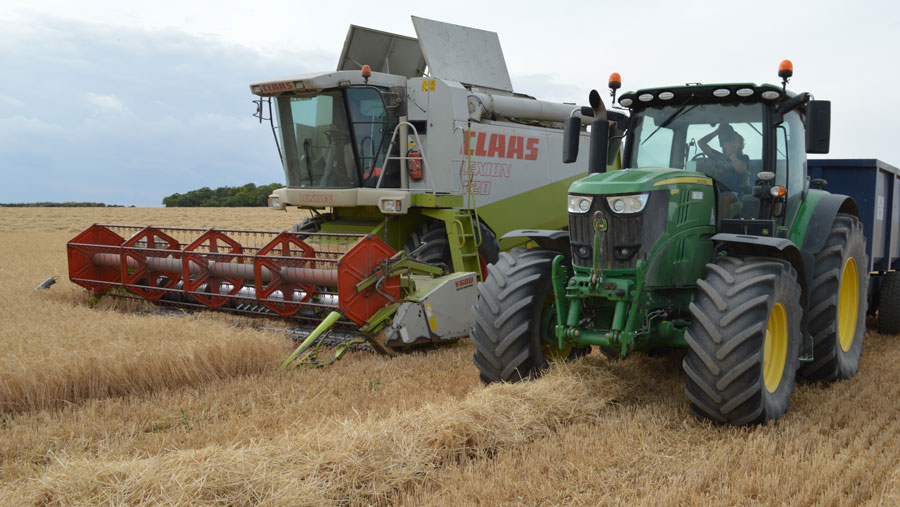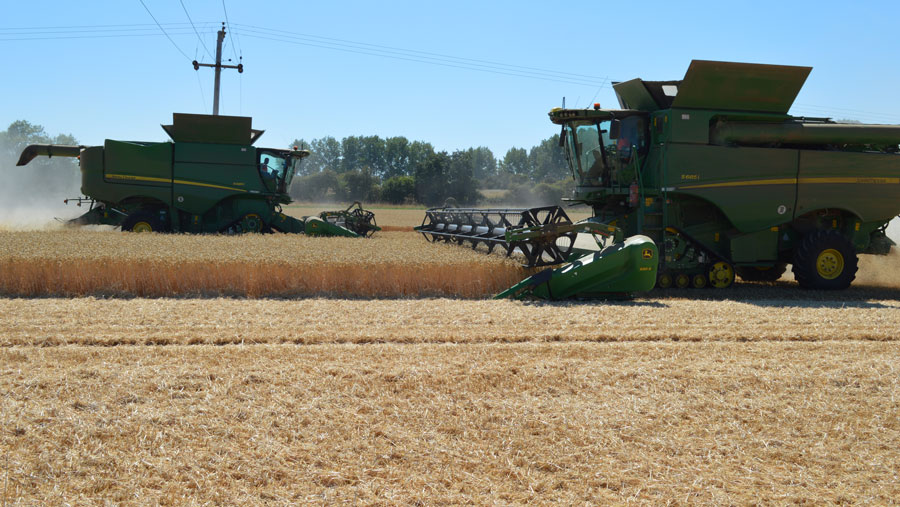Harvest 2022: Spring malting barley quality is high with surprisingly good yields
 © MAG/David Jones
© MAG/David Jones Spring malting barley harvested crops are showing good grain quality with low nitrogen levels and better-than-expected yields, despite the very dry spring and summer and a very early harvest.
Most crops are coming in with grain nitrogen levels below 1.85% in line with maltsters’ needs, and despite often very thin crops, grain weights have been heavy in terms of specific weight, helping to boost overall yields.
Bob King, commercial director of the Crisp Malting Group, says the malting industry needs a big crop as there is little by way of carryover stocks from the previous season, and a good quality spring crop has followed a quality winter malting crop.
“The spring crop is surprisingly good, much better than expected, and everything we have seen is useable, says Mr King, whose company has maltings in East Anglia and Scotland.
See also: Harvest 2022: Hampshire wheat shows high yield despite low protein
Good quality grain
With many of southern and eastern English crops now cut and harvest under way as far north as Morayshire in northern Scotland, the nationwide picture is of surprisingly good yields, low nitrogens and high specific weights.
The prospect of a big high-quality malting crop has seen malting premiums over feed barley narrow to £55-60/t, and this could narrow further as more barley is cut and assessed. This compares with £100/t premiums seen in April and May.
James Beamish, farm manager at the Holkham Estate on the north Norfolk coast, says spring barley yields this summer were down due largely to the lack of rain, and while quality was variable all should go for malting.
The light land estate in the heart of malting barley country grows 400ha of the variety Laureate which showed yields towards 20% down at 5.75t/ha compared with a five-year average of 6.75t/ha, with nitrogen level varying from 1.5% to 1.85%. Specific weights were heavy at 66-68kg/hl with virtually no screenings.
“The spring barley was slightly disappointing in terms of yield, but not unexpected with only 70mm of rain falling since spring drilling on our light Norfolk soils,” he tells Farmers Weekly.
Extra rainfall
Some of the western side of the estate had picked up an extra 14mm of rain in mid-May which the drier eastern side did not, and this led to better yields and lower nitrogen levels.
All of the spring crop is destined for Southwold-based brewer Adnams, which brews Ghost Ship and Broadside beers, and the north Norfolk estate provides 60% of the need of this family-owned Suffolk beermaker.
Mr Beamish says the establishment of spring crops is highly dependent on moisture and getting nitrogen fertiliser into the crop, and this has been made worse with four of the last five springs being very dry.
The estate still plans to grow 400ha next season as it remains a very important crop which fits in well after late-lifted sugar beet in November and December, but the estate will need to think hard about spring crops further out if dry springs continue.
“Getting the consistency in terms of yield and quality is becoming more of a challenge with the dry springs,” he says.
Spring barley is a relatively low input crop, receiving 120kg/ha of liquid nitrogen, split between pre-drilling and when the tramlines are just visible, one herbicide and in the last two years only one fungicide. The estate has a no insecticide policy.
Harvest round-up

Wheat harvest on the Holkham Estate © David Jones
The estate’s 250ha of the winter malting barley variety Craft showed a wide variation in yield, from 5 to 9t/ha with an average of just under 7t/ha compared with a five-year average of 7.25t/ha. Quality was good at 1.50-1.55% nitrogen and specific weight of 70-72kg/hl.
Winter wheat put in a solid performance along with the majority of Norfolk wheat crops, with a yield close to 10t/ha compared with a five-year average of 9.25t/ha. Varieties Gleam, Astronomer and Extase are all grown for feed and gave an impressive specific weight of 79-82kg/hl.
The oilseed rape area has come down to 100ha from nearly 350ha some four years ago due to cabbage stem flea beetle problems, and this season’s crop yielded about 3t/ha compared with a five-year average of 3.5t/ha.
The estate, on the coast north of Fakenham, covers 10,000ha of light land, with 2,500ha in cropping and the rest farmed by tenants or in woodland, parkland, marshes or environmental schemes. Harvest of wheat, barley, rapeseed and beans is set to completed this weekend.

